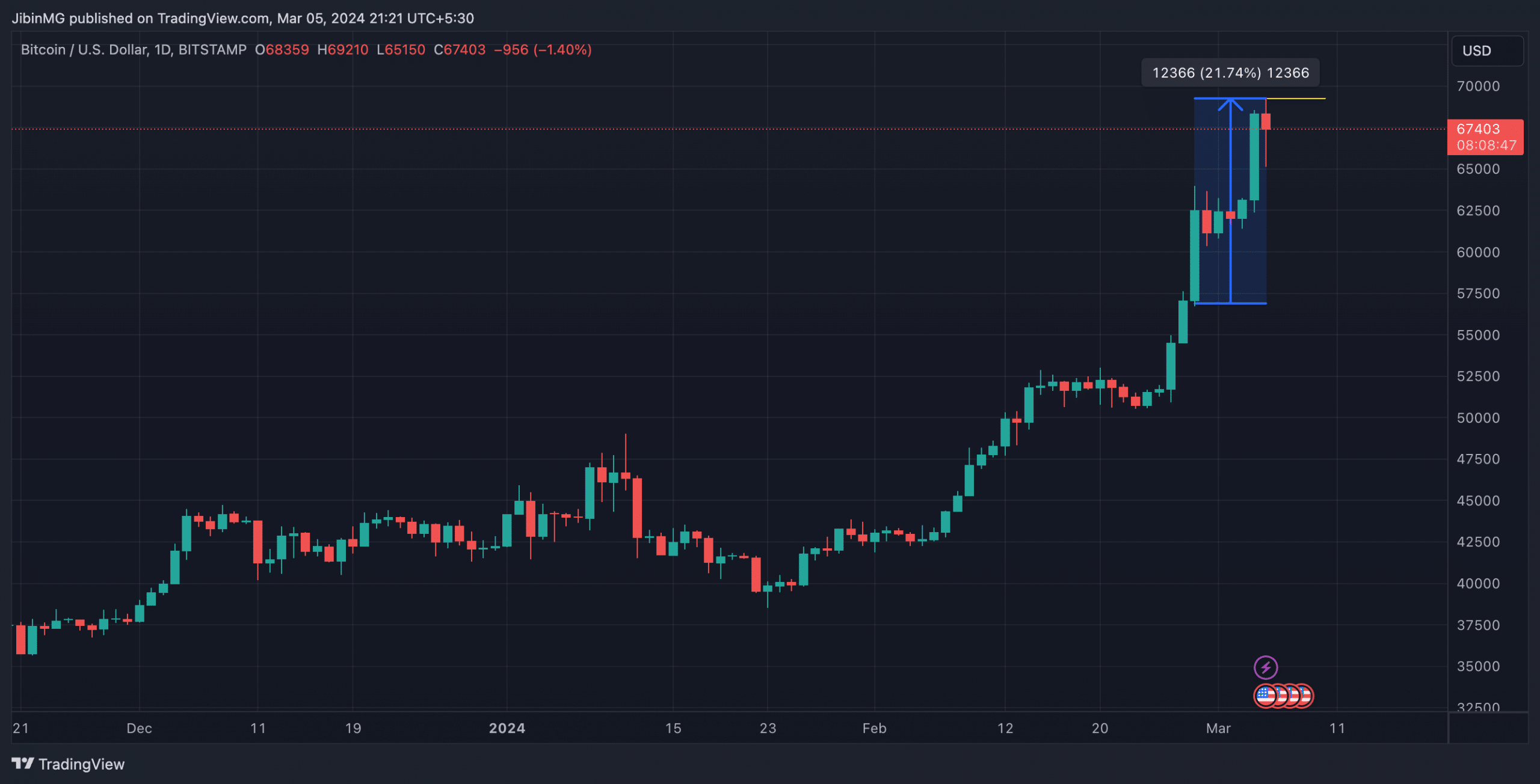Bitcoin
Bitcoin’s new all-time high – The how, why, and future price predictions
Bitcoin has hit a new high a month and a half before its halving. How well it do now?

- Bitcoin’s price went past $69,000 for the first time in almost three years
- Increasing institutional demand and retail return triggered the hike
Maybe you did not expect it, but it has happened. Bitcoin [BTC] hit $69,000 again and has officially punched through its previous all-time high (ATH) on exchanges like Bitstamp and Coinbase. The last time BTC hit this level was in November 2021, meaning it took about two years and three months to reclaim the price.

Source: BTC/USD, TradingView
That being said, at the time of writing, BTC was retracing again, with the crypto valued at just over $67,000 on the charts.
The rise to $69,000 did not just happen without some underlying factors. According to AMBCrypto’s market analysis, both macro factors and on-chain metrics contributed to the landmark.
Demand prints green for BTC
Outside of the on-chain region, the spot ETFs contributed significantly to the resurgent confidence investors have in Bitcoin. For context, Bitcoin ETFs allow investors to have exposure to the coin without necessarily owning BTC.
On the 11th of January, the U.S. SEC approved the ETFs that some asset management firms applied for. At that time, Bitcoin’s price was around $44,000.
Hours after the announcement, the value of the coin rallied to $49,000. Within a short period, the price tumbled. Many market players at that time called the ETF approval a “sell the news” event. However, they did not know that the decline was a “necessary measure” for BTC to quicken its hike. As of this writing, the volume of funds flowing into spot ETFs has been moving at a record pace.
On several occasions, AMBCrypto reported how the daily volume hit high values. However, the tempo has not fallen based on a recent revelation by Senior Bloomberg analyst Eric Balchunas. Balchunas posted that the total daily volume of the ETFs hit $5.5 billion.
Anyone who bought has left the red
This was the second-highest volume since January with Blackrock [IBIT] taking a whopping $2.4 billion out of it. The number here suggests that interest in ETFs has stayed largely positive. From an on-chain perspective, we can look at the Realized Cap too. At press time, Bitcoin’s Realized Cap
was $457 billion. This value was almost the same when the coin hit $69,000 in November 2021.But, why is this metric important in every cycle? Well, the reason is not far-fetched. In simple terms, the Realized Cap provides a historical view of Bitcoin’s price movements. It reflects a more accurate representation of the market by looking at the cost of acquiring compared to the last time they were traded.
This history-based approach makes it different from the market cap. Therefore, the realized cap at press time seemed to imply that almost 100% of investors paid lower acquisition values than they are currently worth.
However, BTC’s journey back to its ATH was not one without challenges. For most of 2022, the broader crypto market went through challenging periods. For those uninitiated at the time, the total crypto market cap lost $2 trillion from its 2021 peak.
Horrible crypto winter sparked doubts about Bitcoin
This nosedive could be linked to many unfortunate events. To start with, Terra Luna [LUNA], a promising project that a large part of the market described as the “future of money” collapsed. This happened in May 2022. Not only did LUNA crash, its stablecoin Terra USD [USTC] also lost its peg to the dollar.
Around that time, investors lost about $60 billion to the market as Bitcoin’s price nosedived to $31,000. However, the onslaught did not stop there as other incidents shattered investors’ confidence.
Firms like Three Arrows Capital (3AC), Celsius, and Voyager Digital could no longer afford operations and opted to declare bankruptcy. However, the nail to the coffin was in November of the same year. This time, FTX, led by Sam Bankman-Fried, collapsed.
After word got out that FTX had used customer funds inappropriately, BTC crashed below $16,000. Fast forward to 2023, the coin redeemed itself, ending the year above $43,000.
Price predictions set sights on six-figures
With all of that behind Bitcoin, the coin seems set to hit a new ATH. One metric that has aligned with this forecast is the stock-to-flow ratio. This metric measures the annual flow of new coins. If the stock-to-flow ratio is low, it implies that Bitcoin’s scarcity has fallen.
At press time, Bitcoin’s stock-to-flow ratio had climbed significantly, indicating higher scarcity. The higher the scarcity, the higher the chance of a value increase. Like the aforementioned ratio, the Weighted Sentiment was at 2.62, at press time.
As a measure of perception, the reading here suggests that many market players are bullish on BTC. The sentiment could turn into action and drive demand for the coin.
Read Bitcoin’s [BTC] Price Prediction 2024-2025
In the meantime, some major market players have predicted how far Bitcoin might go. One of them is William Quigley, co-founder of Tether. Speaking to CNBC, Quigley noted that the market is in better shape now. He said,
“The ETFs have surprised me. I was a little skeptical about it. But the 740,000 BTC inflow has been amazing. This rally may be the biggest we’ve seen. When considering history, it would suggest that Bitcoin would hit $300,000 at the peak of the next bull market.”

